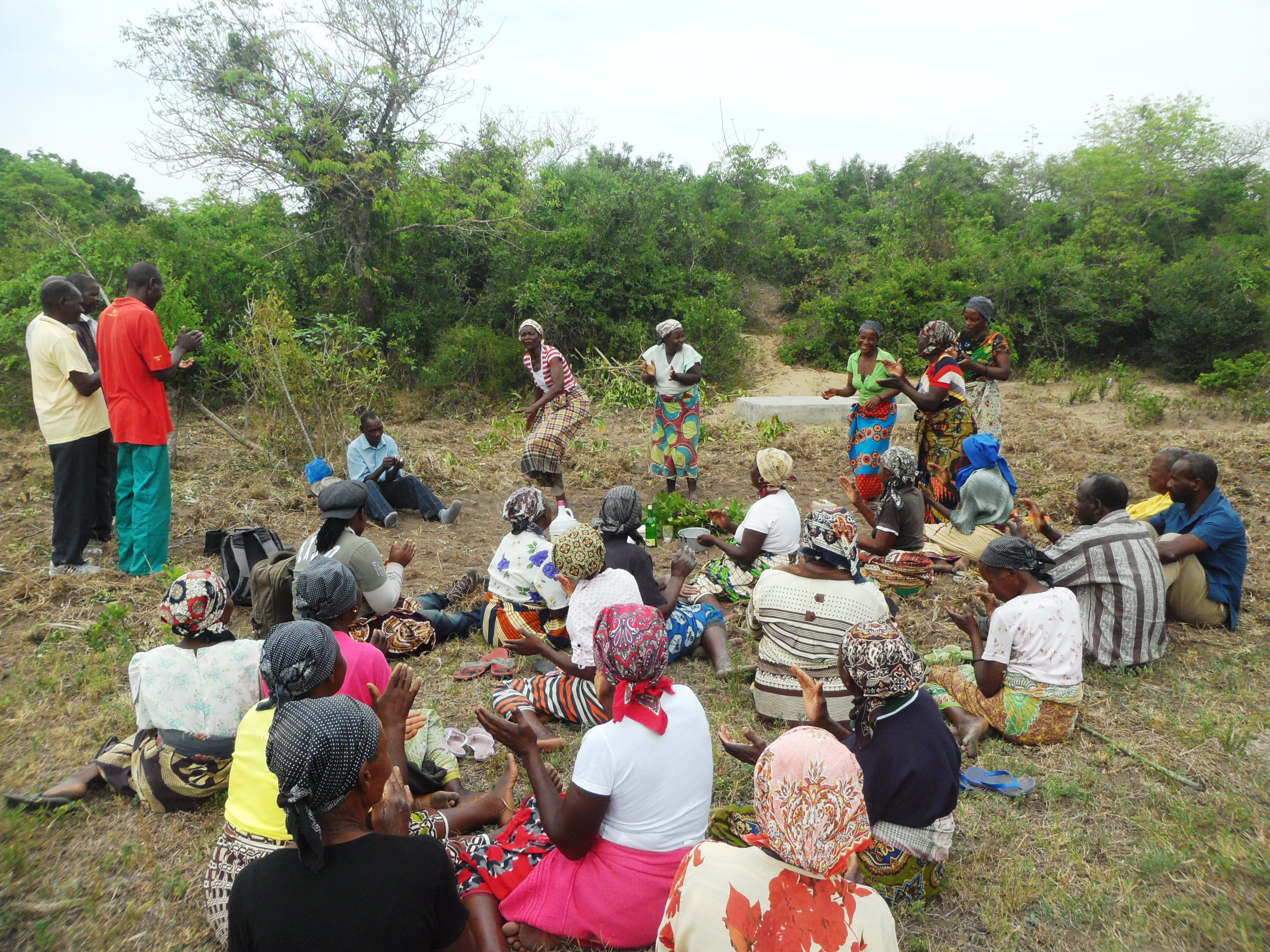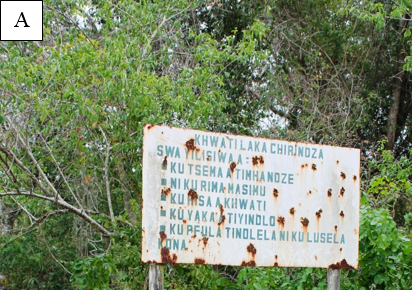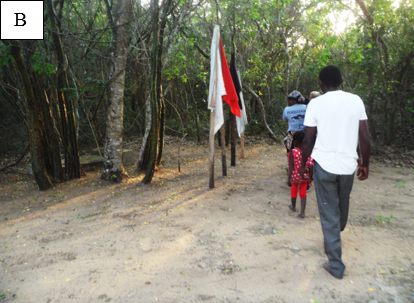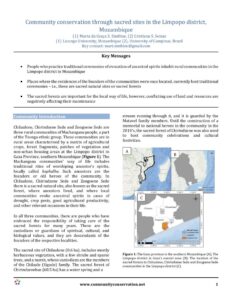
28 Oct Limpopo District, Mozambique
KEY MESSAGES
- People who practice traditional ceremonies of evocation of ancestral spirits inhabit rural communities in the Limpopo district in Mozambique
- Places where the residences of the founders of the communities were once located, currently host traditional ceremonies – i.e., these are sacred natural sites or sacred forests
- The sacred forests are important for the local way of life, however, conflicting use of land and resources are negatively affecting their maintenance
(1) Marta da Graça Z. Simbine (2) Cristiana S. Seixas
(1) Licungo University, Mozambique (2) University of Campinas
Key contact:mart.simbine@gmail.com
Community Introduction
Chilaulene, Chirindzene Sede and Zongoene Sede are three rural communities of Machangana people, a part of the Tsonga ethnic group. These communities are in rural areas characterised by a matrix of agricultural crops, forest fragments, patches of vegetation and non-urban housing areas at the Limpopo district in Gaza Province, southern Mozambique (Figure 1). The Machangana communities’ way of life includes traditional rites of worshiping ancestor’s spirits, locally called kuphalha. Such ancestors are the founders or old heroes of the community. In Chilaulene, Chirindzene Sede and Zongoene Sede there is a sacred natural site, also known as the sacred forest, where ancestors lived, and where local communities evoke ancestral spirits in cases of drought, crop pests, good agricultural productivity, and other relevant occasions in their life.
In all three communities, there are people who have embraced the responsibility of taking care of the sacred forests for many years. These are the custodians or guardians of spiritual, cultural, and biological values, and they are descendants of the founders of the respective localities. The sacred site of Chilaulene (0.6 ha), includes mostly herbaceous vegetation, with a few shrubs and sparse trees, and a marsh, whose custodians are the members of the Chilaule (Sigode) family. The sacred forest of Chirindzenehas (60.5 ha) has a water spring and a stream running through it, and it is guarded by the Matavel family members. Until the construction of a memorial to national heroes in the community in the 2010’s, the sacred forest of Chirindzene was also used to host community celebrations and cultural festivities.

Figure 1: The Gaza province in the southern Mozambique (A); The Limpopo district in Gaza’s coastal zone (B); The location of the sacred forests in Chilaulene, Chirindzene Sede and Zongoene Sede communities in the Limpopo district (C).
Nowadays, it is strictly used for traditional ceremonies. The sacred forest of Zongoene (7.0 ha), also known as sacred forest of Xirhaminhane Mhula, is guarded by the Mhula (Michavo) family members. Small-scale agriculture is the main source of livelihood for the three communities, followed by small-scale livestock rearing, artisanal fishing and charcoal production.
Conservation Challenges
The view of nature conservation of the rural Machangana communities of Limpopo district resembles the conservation vision of the environmental sciences, since it also seeks to safeguard a given ecosystem due to its intrinsic value. However, the main motivation for conservation for the rural communities of Limpopo district is its symbolic value. Thus, the criteria of evaluation of the conservation status of the sacred natural sites takes into account the biophysical factors (e.g. fragment size, tree density and size, vegetation biodiversity) and also social factors (cleanliness of the main entrance, existence of constructions and artefacts that symbolize the sacredness, respect for institutions, engagement of the local community in traditional ceremonies, and frequency of visitors). Below, we present the challenges for conservation of each of these sacred natural sites by considering these factors.
In all the communities, the spiritual invocation ceremonies tend to be modified from the traditional ways, due to the lack of financial means to cater for the expenses that a traditional ceremony entails or to facilitate the presence of visitors. There is also less adherence by local people to the ceremonies due to changes in the spiritual values of the members of the communities. This is caused mainly by the emergence of new religious sects or governance dynamics imposed by the formal governance. Another challenge is that all sacred natural sites have vestiges of uses not allowed by local institutions, probably caused by inhabitants who are unaware of the sacredness or do not share belief in the sacredness of these sites.
Challenges for conserving the sacred site of Chilaulene
One of the major challenges for the preservation of the sacred forest of Chilaulene relates to small-scale livestock farming. The lack of a properly organized cattle-drinking system forces herdsmen to lead their cattle to the pond that is part of the sacred site, causing its degradation. In doing so, they contribute to the weakening of the sacred vision that the community members have had over that natural monument, as it represents a non-spiritual use and therefore not accepted by local institutions. Watering the cattle at the sacred site pond has led to the decreasing conservation status, and consequent diminishing local community awareness of the sacredness.
Another challenge emerged in the mid-1970s, when part of the sacred site was converted into a cemetery for the burial of community members. Moreover, not all the Chilaulene community members are aware of the existence of a sacred site adjacent to the community cemetery. This may be associated with a lack of artifacts that would signalize the sacredness of the place. Therefore, part of the portion that remained for ceremonies of evocation of the ancestral spirits nowadays holds graves of other people.
Challenges for conserving the sacred forest of Chirindzene
Many members of the Chirindzene Sede community claim that the sacred forest guarantees water in the village and without it they would die of thirst. This conviction arises from the fact that the creek that emerges in the forest has been the main source of water up until 10 years ago when the government started drilling boreholes in the community. Prior to this, the management of the stream and its banks sought to ensure that the water remained sufficiently clean for human consumption. However, after the drill of boreholes, only a small fraction of the community uses the stream (to wash clothes and watering the cattle). This has led to poor management and reduction of the water quality.
The community is also facing a reduction in actions that promotes the visibility of the sacred forest, both inside and outside the village, threatening the perpetuation of local community lifestyles. This situation arises from two main reasons: (1) the numbers of visits by national and foreign people and (2) the celebrations of national commemorative dates or local festivities are diminishing.
Challenges for conserving sacred forest of Zongoene
After the Mozambique civil war (from the 1970s to the early 1990s), many non-natives migrated to the residential areas of Zogoene Sede. As they needed land for agriculture, they converted part of the sacred forest into fields, reducing its area. Additionally, the newcomers settle their housing close to center of the neighbourhoods and far away from the forest. The distance among residential neighbourhoods and disputes among local leaders of each neighbourhood contribute to a significant part of the residents not engaging in traditional ceremonies of the sacred forest of Zongoene.
Community Initiatives
Despite the reported challenges, community members have been engaging in some initiatives to minimize them and to maintain their traditional ceremonies, which for a long time have constituted their way of life.
The traditional leaders of the Chilaulene community are taking the lead in the efforts of preventing the conversion of the entire area of the sacred site into a cemetery. In effect, the custodians of the sacred site have sought to avoid that new graves are established in the remaining portion of the sacred site, in addition to the appeals for the exhumation of the bodies buried in the portion already transformed into a cemetery.
In Chirindzene Sede, between 2002 and 2005, the local community, supported by the Community Association for Health and Development (Associação Comunitária para Saúde e Desenvolvimento – ACOSADE), implemented an initiative for conservation of the sacred forest of Chirindzene. This initiative resulted in the delimitation of that sacred forest, placement of plates inscribing local rules (prohibitions) related to the forest (Figure 2), as well as the construction of huts at the entrance of forest. These actions have had a positive impact, since the whole community now knows the significance of this place. Under the same project, honeybee hives were built for honey production and generation of alternative income for community members, but the lack of technical assistance led to failure of this activity.
In the beginning of the 2000s, the community of Zongoene Sede joined efforts to build a hut with cement and other more resistant materials replacing the previous one built with local material. In addition, in 2012 the community, in collaboration with the environmental authorities of Gaza Province, reforested with Eucalyptus sp (an exotic species) at least ¼ the forest area previously deforested.


Figure 2: Prohibitions related to the sacred forest of Chirindzene written in xichangana: “It is forbidden to cut tree branches, to practice agriculture, to burn, to build housing, to clear path/short cuts and to heard animals”. (A) and the traditional ceremony in the sacred forest of Zongoene (B).
Practical Outcomes
The Limpopo district belongs to the Maputaland centre of endemism, an ecoregion of global interest for the conservation of biodiversity. By conserving their sacred natural sites, the communities of Chilaulene, Chirindzene Sede and Zongoene Sede are contributing for conserving the biodiversity of the Maputaland forest mosaic, including endemic species of trees and, probably of other groups of living beings as well.
In addition to the immaterial benefit of spiritual use (which contributes to strengthening the identity of local communities), the three communities also get other benefits from their sacred natural sites. These benefits include other immaterial benefits (e.g., sense of place, leisure and learning), material benefits (such as food and medicinal resources), and regulating benefits (such as regulation of the quantity and quality of freshwater and the microclimate regulation).
The above context described here has resulted from the attempt to register the institutions and context underlining natural sacred natural sites in Mozambique (Simbine, 2020) – a country with deficiency in several ecological, social and anthropological data sets. Through this research, we found that most of the challenges to the conservation of the sacred natural sites are potentially minimized by raising awareness of the existence and importance of sacred natural sites among all community members and empowering the local communities, and in particularly the custodians, to deal with pressures posed by government. We understand that this research is an important step towards increasing awareness on sacred natural sites, and we hope that this contact with custodians of sacred natural sites, may reverberate in future collaboration with external actors.
Acknowledgements
We thank the population of Chilaulene, Chirindzene Sede and Zongoene Sede for their availability to contribute to our research. We also thank the São Paulo Funding Agency (FAPESP grant 15/19439-8) and SSHRC/CCRN for supporting field research and the Coordination for the Improvement of Higher Education Personnel (CAPES) for M.G.Z.S. Ph.D. Scholarship.
References
Simbine, M.G.Z. (2020). ‘Instituições Informais e Contribuições da Natureza para as Pessoas: Subsídios para a Conservação das Florestas Sagradas em Moçambique’ (Informal Institutions and Nature’s Contributions to People: Guidance for Conserving Sacred Forests in Mozambique). Ph.D. Dissertation in Ecology, University of Campinas, Brasil.



